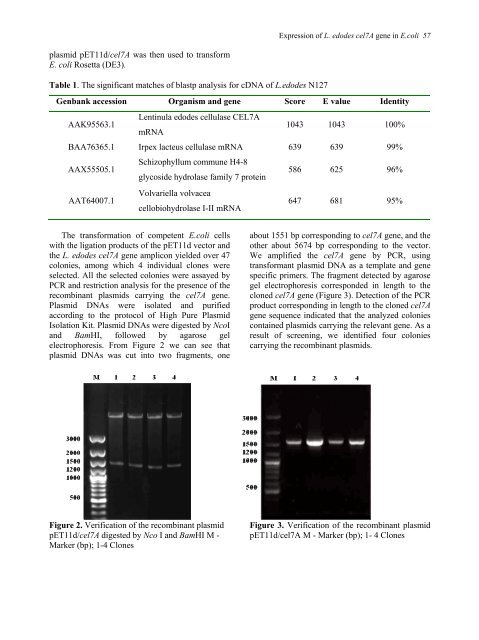Vol 9 No1 - Journal of Cell and Molecular Biology - Haliç Üniversitesi
Vol 9 No1 - Journal of Cell and Molecular Biology - Haliç Üniversitesi
Vol 9 No1 - Journal of Cell and Molecular Biology - Haliç Üniversitesi
Create successful ePaper yourself
Turn your PDF publications into a flip-book with our unique Google optimized e-Paper software.
plasmid pET11d/cel7A was then used to transform<br />
E. coli Rosetta (DE3).<br />
Table 1. The significant matches <strong>of</strong> blastp analysis for cDNA <strong>of</strong> L.edodes N127<br />
Expression <strong>of</strong> L. edodes cel7A gene in E.coli 57<br />
Genbank accession Organism <strong>and</strong> gene Score E value Identity<br />
AAK95563.1<br />
Lentinula edodes cellulase CEL7A<br />
mRNA<br />
1043 1043 100%<br />
BAA76365.1 Irpex lacteus cellulase mRNA 639 639 99%<br />
AAX55505.1<br />
Schizophyllum commune H4-8<br />
glycoside hydrolase family 7 protein<br />
586 625 96%<br />
AAT64007.1<br />
<strong>Vol</strong>variella volvacea<br />
cellobiohydrolase I-II mRNA<br />
The transformation <strong>of</strong> competent E.coli cells<br />
with the ligation products <strong>of</strong> the pET11d vector <strong>and</strong><br />
the L. edodes cel7A gene amplicon yielded over 47<br />
colonies, among which 4 individual clones were<br />
selected. All the selected colonies were assayed by<br />
PCR <strong>and</strong> restriction analysis for the presence <strong>of</strong> the<br />
recombinant plasmids carrying the cel7A gene.<br />
Plasmid DNAs were isolated <strong>and</strong> purified<br />
according to the protocol <strong>of</strong> High Pure Plasmid<br />
Isolation Kit. Plasmid DNAs were digested by NcoI<br />
<strong>and</strong> BamHI, followed by agarose gel<br />
electrophoresis. From Figure 2 we can see that<br />
plasmid DNAs was cut into two fragments, one<br />
Figure 2. Verification <strong>of</strong> the recombinant plasmid<br />
pET11d/cel7A digested by Nco I <strong>and</strong> BamHI M -<br />
Marker (bp); 1-4 Clones<br />
647 681 95%<br />
about 1551 bp corresponding to cel7A gene, <strong>and</strong> the<br />
other about 5674 bp corresponding to the vector.<br />
We amplified the cel7A gene by PCR, using<br />
transformant plasmid DNA as a template <strong>and</strong> gene<br />
specific primers. The fragment detected by agarose<br />
gel electrophoresis corresponded in length to the<br />
cloned cel7A gene (Figure 3). Detection <strong>of</strong> the PCR<br />
product corresponding in length to the cloned cel7A<br />
gene sequence indicated that the analyzed colonies<br />
contained plasmids carrying the relevant gene. As a<br />
result <strong>of</strong> screening, we identified four colonies<br />
carrying the recombinant plasmids.<br />
Figure 3. Verification <strong>of</strong> the recombinant plasmid<br />
pET11d/cel7A M - Marker (bp); 1- 4 Clones

















